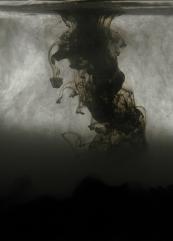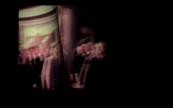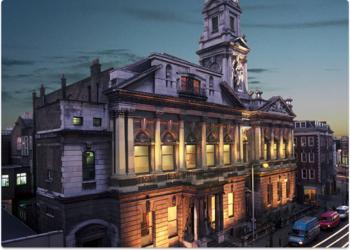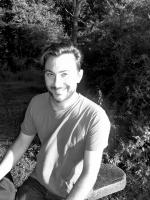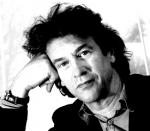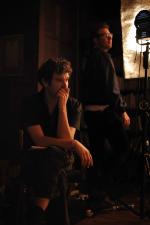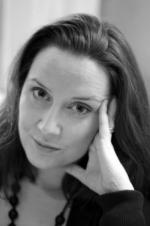Background
A SHORT HISTORY OF VIDEO PAINTING
Some art movements begin with a political agenda, others with a technique or style. Video painting began with a philosophy.
In 2001, Hilary Lawson published 'Closure'. It had taken him twelve years to write. It was the culmination of twenty years grappling with what he saw as the impending crisis of postmodernism. In the mid eighties, Hilary Lawson had called the end of postmodernism with a book called 'Reflexivity: the post-modern predicament' in which he argued that postmodernism was trapped in a vicious self-referential circle. In 'Closure' he put forward an alternative.
'Closure' did not offer a return to the safe havens of realism, objectivity and truth. Instead he proposed that the world is open, and we close that openness with thought and language. The human condition is to find ourselves on the cusp of openness and closure, on the boundary of the openness of the world and the closure of thought and language. Art was reinterpreted, and in part defined, as the attempt to avoid closure and approach openness.
"What distinguishes art from knowledge is the acceptance of the failure of closure and the avoidance of an attempt to complete closure" Hilary Lawson, Closure 2001.
Aside from his philosophical writings, during the late eighties and nineties he had also gained a reputation as a documentary film-maker. In the wake of 'Closure' he came to see these films, and film in general, as exercises in the completion of narrative and set out to create material that would avoid closure and thereby approach openness.
At first not knowing how to begin, he set up his camera and sought a subjectless frame. After a number of failed attempts, he kept the camera static to avoid introducing meaning, and settled on a section of the sky which was abstract in character and allowed the camera to run. Despite its seeming trivial simplicity, completing the shot he was surprised to realise that in the many years of making films he had not come across, or himself shot, material like this.
The following day he viewed the material projected onto a large screen and was at once intrigued by the outcome. In the frame were changes of colour and light so complex and subtle that they defied description. The eye travelled over the surface watching and noting detail that would normally go unnoticed. And in that visual journey, different on every viewing, he believed there was indeed some small step out of closure and into being or openness.
Over the following year he shot a great deal of material seeking to explore and understand the facets of this new format which he called video painting. In particular he sought to identify what characteristics were required of video paintings for them to shift the gaze of the viewer from the identification of narrative and closure to the exploration of what he saw as the unlimited potential of visual space. Having identified some ground rules, he then set out to find others who might share his enthusiasm for this new medium. Working with a close friend and artist, Sanchita Islam, a small initial group was formed which also included William Raban, Isabelle Inghillieri, Nina Danino and Tina Keane. The group met regularly and discussed and shared their work.
The video painting was defined. The camera is stationary. There can be no subsequent editing or manipulation of the image. There is no dialogue, no sound.
In the context of this definition, video painting could be seen to have its precursors in the long almost static shots which made up Warhol’s non-narrative films such as Sleep (1963) and Gillian Wearing's 1997 Turner Prize piece Sixty Minutes Silence which resolutely fixed its frame over an almost still group portrait.
In 2003, working with a computer scientist, William Sowerbutts, technology was developed to enable the video paintings to be combined so that they could form collections of work that never repeated and yet had structure. This technology enabled artists to title each video painting and create collections consisting of a series of individual video paintings which in combination were capable of overcoming the traditional limitation of video art: the looped nature of the work.
Then in 2006, Open Gallery was formed as a platform for the presentation of work by this group of video artists. The first public installation took place in the UK later in the same year. Exhibitions at the Institute of Contemporary Arts (2006), Sketch Gallery (2007), the Hayward Gallery (2007), Crunch (2008), Shunt (2009), HowTheLightGetsIn (2009), The Miami Ice Palace (2009), the Square gallery (2010) and the Hospital Club (2010) have followed.
Since 2006 a growing number of artists have become involved in the project, exploring the potential of the video painting with differing responses to it: from the half seen, half understood mists of Sarah Turner’s collection ‘Lake Baikal’ to the exploration of the transient relationship between nature and architecture in Alys Williams’ video works, to the recurring human presence elegantly explored within Gabrielle Le Bayon’s collections and George Barber's use of random human intervention in his action paintings.
Looking back it is now possible to see a progression in the eight years since the early video paintings. Against the backdrop of a visual world of moving images driven solely by narrative and closure, the early video paintings sought above all to escape those narratives. Gradually elements of narrative have been reintroduced. In place of the predominantly naturalistic early work, urban material was introduced and the human subject began to play a larger role. Instead of seeking to escape narrative altogether and immerse the viewer in being, the video paintings increasingly proposed narratives only to allow them to be undermined.
'The attempt to avoid closure cannot be achieved by simply abandoning closure altogether, but requires the suggestion of closure: the offer of closure that is then denied. If insight alone were the defining characteristic of art it would apply equally to the scientist; what distinguishes the artist is the offer of closure that cannot come to rest and so cannot be completed.'
The submissions for the Open Prize are the latest addition to the unfolding development of video painting. They are startling in their variety, strength and excitement with the medium of the video painting. It is at once apparent that as the video painting movement approaches its first decade it has so far only begun in its exploration of the medium. We have yet to live with these works and with time we will no doubt come to appreciate those that have lasting depth from those that are more superficially compelling. But there is no doubt that the video painting story has hardly begun.






